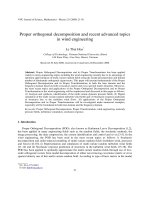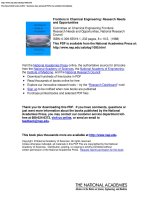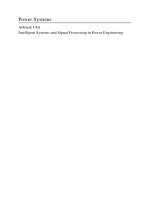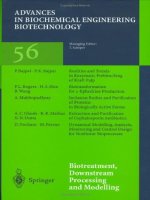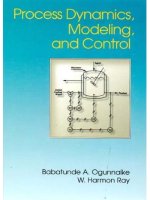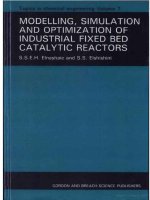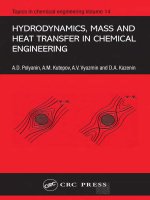nonlinear and mixed integer optimization fundamentals and applications topics in chemical engineering
Bạn đang xem bản rút gọn của tài liệu. Xem và tải ngay bản đầy đủ của tài liệu tại đây (15.26 MB, 475 trang )
To
my
wife,
Fotini
This page intentionally left blank
Preface
Nonlinear
and
Mixed-Integer Optimization addresses
the
problem
of
optimizing
an
objective
function
subject
to
equality
and
inequality
constraints
in the
presence
of
continuous
and
integer
variables.
These
optimization
models
have many applications
in
engineering
and
applied science
problems
and
this
is the
primary motivation
for the
plethora
of
theoretical
and
algorithmic devel-
opments that
we
have been experiencing during
the
last
two
decades.
This
book
aims
at
presenting
the
fundamentals
of
nonlinear
and
mixed-integer optimization,
and
their
applications
in the
important area
of
process
synthesis
and
chemical engineering.
The
first
chapter introduces
the
reader
to the
generic
formulations
of
this class
of
optimization prob-
lems
and
presents
a
number
of
illustrative applications.
For the
remaining chapters,
the
book con-
tains
the
following
three
main parts:
Part
1:
Fundamentals
of
Convex Analysis
and
Nonlinear Optimization
Part
2:
Fundamentals
of
Mixed-Integer Optimization
Part
3:
Applications
in
Process
Synthesis
Part
1,
comprised
of
three chapters, focuses
on the
fundamentals
of
convex analysis
and
non-
linear optimization. Chapter
2
discusses
the key
elements
of
convex analysis (i.e., convex sets,
convex
and
concave
functions,
and
generalizations
of
convex
and
concave
functions),
which
are
very
important
in the
study
of
nonlinear optimization problems. Chapter
3
presents
the
first
and
second order optimality conditions
for
unconstrained
and
constrained nonlinear optimization.
Chapter
4
introduces
the
basics
of
duality
theory (i.e.,
the
primal problem,
the
perturbation
func-
tion,
and the
dual problem)
and
presents
the
weak
and
strong duality theorem along with
the
dual-
ity
gap. Part
1
outlines
the
basic notions
of
nonlinear optimization
and
prepares
the
reader
for
Part
2.
Part
2,
comprised
of two
chapters, addresses
the
fundamentals
and
algorithms
for
mixed-inte-
ger
linear
and
nonlinear optimization models. Chapter
5
provides
the
basic ideas
in
mixed-inte-
ger
linear optimization, outlines
the
different
methods,
and
discusses
the key
elements
of
branch
and
bound approaches. Chapter
6
introduces
the
reader
to the
theoretical
and
algorithmic devel-
opments
in
mixed-integer nonlinear optimization.
After
a
brief description
of the
motivation
and
the
formulation
of
such models,
the
reader
is
introduced
to (i)
decomposition-based approaches
(e.g., Generalized Benders Decomposition, Generalized
Gross
Decomposition), (ii) linearization-
based methods (e.g., Outer Approximation
and its
variants
with
Equality
Relaxation
and
Augmented
Penalty,
and
Generalized Outer Approximation),
and
(iii) comparison between
decomposition-
and
linearization-based methods.
viii
Part
3,
consisting
of
four
chapters,
deals
with important application
areas
in
chemical engi-
neering. Chapter
7
discusses
the
components
of a
chemical process system,
defines
the
objectives
in
the
area
of
process synthesis,
and
presents
the
different
approaches
in
process synthesis.
Subsequently,
the
reader
is
introduced
to
modeling
issues
in
mixed-integer
nonlinear
optimiza-
tion problems
of
process synthesis. Chapter
8
presents
the
application area
of
heat exchanger net-
work
synthesis.
The
reader
is
introduced
to
optimization models that correspond
to (i)
targeting
methods
for
minimum utility
cost
and
minimum number
of
matches, (ii)
decomposition-based
methods,
and
(iii) simultaneous optimization approaches
for the
synthesis
of
heat recovery net-
works. Chapter
9
presents applications
of
mixed-integer nonlinear optimization
in the
area
of
separations.
In
particular,
the
synthesis
of
sharp heat-integrated
distillation
columns
and the
syn-
thesis
of
non-sharp separation columns
are
addressed. Chapter
10
discusses
the
application
of
mixed-integer nonlinear optimization methods
in the
synthesis
of
reactor networks
with
complex
reactions
and in the
synthesis
of
prototype chemical processes consisting
of
reactor-separator-
recycle systems.
The
main
objectives
in the
preparation
of
this book
are (i) to
acquaint
the
reader
with
the
basics
of
convex analysis
and
nonlinear optimization without presenting
the
proofs
of the
theoret-
ical results
and the
algorithmic details, which
can be
found
in
several other textbooks, (ii)
to
intro-
duce
the
reader
to the
elementary notions
of
mixed-integer linear optimization
first and to the
the-
ory and
methods
of
mixed-integer nonlinear optimization next, which
are not
discussed
in
other
textbooks,
and
(iii)
to
consider several
key
application areas
of
chemical engineering process syn-
thesis
and
design
in
which
the
mixed-integer nonlinear optimization models
and
methods apply
naturally.
Special
efforts
have been made
so as to
make this book self-contained,
and
establish
only
the
needed
fundamentals
in
Part
1 to be
used
in
Part
2. The
modeling issues
and
application areas
in
Part
3
have been selected
on the
basis
of the
most
frequently
studied
in the
area
of
process syn-
thesis
in
chemical engineering.
All
chapters have several illustrations
and
geometrical interpreta-
tions
of the
theoretical results presented; they include
a
list
of
recommended books
and
articles
for
further
reading
in
each discussed topic,
and the
majority
of the
chapters contain suggested prob-
lems
for the
reader. Furthermore,
in
Part
3 the
examples considered
in
each
of the
application areas
describe
the
resulting mathematical models
fully
with
the key
objective
to
familiarize
the
reader
with
the
modeling aspects
in
addition
to the
algorithmic ones.
This book
has
been prepared keeping
in
mind that
it can be
used
as a
textbook
and as a
ref-
erence.
It can be
used
as a
textbook
on the
fundamentals
of
nonlinear
and
mixed-integer opti-
mization
and as a
reference
for
special topics
in the
mixed-integer nonlinear optimization part
and
the
presented application areas. Material
in
this book
has
been used
in
graduate level courses
in
Optimization
and
Process synthesis
at
Princeton University, while Parts
1 and 2
were presented
in
a
graduate level course
at
ETH.
Selected
material, namely chapters
3,5,7,
and 8, has
been used
in
the
undergraduate design course
at
Princeton University
as an
introduction
to
optimization
and
process synthesis.
A
number
of
individuals
and
institutions deserve acknowledgment
for
different
kinds
of
help.
First,
I
thank
my
doctoral students, postdoctoral associates, colleagues,
and in
particular,
the
chairman, Professor William
B.
Russel,
at
Princeton University
for
their support
in
this
effort.
Second,
I
express
my
gratitude
to my
colleagues
in the
Centre
for
Process Systems Engineering
at
Imperial College
and in the
Technical Chemistry
at ETH for the
stimulating environment
and
support they provided during
my
sabbatical leave. Special thanks
go to
Professors John Perkins,
Roger
W. H.
Sargent,
and
David
W. T.
Rippin
for
their instrumental
role
in a
productive
and
enjoyable
sabbatical. Third,
I am
indebted
to
several colleagues
and
students
who
have provided
inspiration, encouragement, extensive feedback,
and
helped
me to
complete this book.
The
thought-
Preface
ix
ful
comments
and
constructive criticism
of
Professors Roger
W. H.
Sargent,
Roy
Jackson,
Manfred
Morari,
Panos
M.
Pardalos,
Amy R.
Ciric,
and Dr.
Efstratios
N.
Pistikopoulos have
helped
enormously
to
improve
the
book. Claire
Adjiman,
Costas
D.
Maranas, Conor
M.
McDonald,
and
Vishy
Visweswaran critically read several manuscript
drafts
and
suggested
helpful
improvements.
The
preparation
of the
camera-ready copy
of
this
book
required
a
significant
amount
of
work.
Special thanks
are
reserved
for
Costas
D.
Maranas, Conor
M.
McDonald
and
Vishy
Visweswaran
for
their time, LaTex expertise,
and
tremendous help
in the
preparation
of
this
book.
Without their
assistance
the
preparation
of
this book would have taken much longer time.
I am
also
thankful
for
the
excellent
professional
assistance
of the
staff
at
Oxford University
Press,
especially
Karen
Boyd,
who
provided detailed editorial comments,
and
senior editor Robert
L.
Rogers. Finally
and
most importantly,
I am
very
grateful
to my
wife,
Fotini,
and
daughter, Ismini,
for
their support,
encouragement,
and
forbearance
of
this seemingly never ending task.
C.A.F.
Princeton,
New
Jersey
March
1995
This page intentionally left blank
Contents
1.
Introduction,
3
1.1
Mathematical
and
Optimization
Models,
3
1.2
Structure
of
Nonlinear
and
Mixed-Integer Optimization Models,
4
1.3
Illustrative Applications,
5
1.3.1 Binary Distillation Design,
6
1.3.2 Retrofit Design
of
Multiproduct Batch Plants,
8
1.3.3 Multicommodity Facility Location—Allocation,
11
1.4
Scope
of the
Book,
12
PART
1
FUNDAMENTALS
OF
CONVEX ANALYSIS
AND
NONLINEAR
OPTIMIZATION
2.
Convex Analysis,
17
2.1
Convex
Sets,
17
2.1.1 Basic Definitions,
17
2.1.2 Convex Combination
and
Convex Hull,
20
2.1.3 Separation
of
Convex Sets,
22
2.1.4
Support
of
Convex Sets,
24
2.2
Convex
and
Concave Functions,
24
2.2.1 Basic Definitions,
25
2.2.2 Properties
of
Convex
and
Concave Functions,
25
2.2.3 Continuity
and
Semicontinuity,
27
2.2.4 Directional Derivative
and
Subgradients,
30
2.2.5 Differentiable Convex
and
Concave Functions,
31
2.2.6 Minimum
(Infimum)
and
Maximum (Supremum),
34
2.2.7
Feasible
Solution, Local
and
Global Minimum,
36
2.3
Generalizations
of
Convex
and
Concave Functions,
37
2.3.1 Quasi-convex
and
Quasi-concave Functions,
37
2.3.2
Properties
of
Quasi-convex
and
Quasi-concave Functions,
39
2.3.3 Differentiable Quasi-convex, Quasi-concave Functions,
40
2.3.4 Pseudo-convex
and
Pseudo-concave Functions,
40
2.3.5
Properties
of
Pseudo-convex
and
Pseudo-concave Functions,
40
2.3.6 Relationships among Convex, Quasi-convex
and
Pseudo-convex Functions,
41
xii
3.
Fundamentals
of
Nonlinear
Optimization,
45
3.1
Unconstrained Nonlinear Optimization,
45
3.1.1 Formulation
and
Definitions,
45
3.1.2 Necessary Optimality Conditions,
46
3.1.3
Sufficient
Optimality Conditions,
47
3.1.4 Necessary
and
Sufficient
Optimality Conditions,
48
3.2
Constrained Nonlinear Optimization,
49
3.2.1 Formulation
and
Definitions,
49
3.2.2 Lagrange Functions
and
Multipliers,
51
3.2.3 Interpretation
of
Lagrange Multipliers,
52
3.2.4 Existence
of
Lagrange Multipliers,
54
3.2.5 Weak Lagrange Functions,
56
3.2.6 First-Order Necessary Optimality Conditions,
56
3.2.7 First-Order
Sufficient
Optimality Conditions,
61
3.2.8 Saddle Point
and
Optimality Conditions,
62
3.2.9 Second-Order Necessary Optimality Conditions,
64
3.2.10 Second-Order
Sufficient
Optimality Conditions,
67
3.2.11 Outline
of
Nonlinear Algorithmic Methods,
68
4.
Duality Theory,
75
4.1
Primal
Problem,
75
4.1.1 Formulation,
75
4.1.2 Perturbation Function
and Its
Properties,
76
4.1.3 Stability
of
Primal
Problem,
76
4.1.4 Existence
of
Optimal Multipliers,
77
4.2
Dual Problem,
77
4.2.1 Formulation,
78
4.2.2 Dual Function
and Its
Properties,
78
4.2.3 Illustration
of
Primal-Dual Problems,
79
4.2.4
Geometrical
Interpretation
of
Dual
Problem,
80
4.3
Weak
and
Strong Duality,
82
4.3.1 Illustration
of
Strong Duality,
84
4.3.2 Illustration
of
Weak
and
Strong Duality,
85
4.3.3 Illustration
of
Weak Duality,
86
4.4
Duality
Gap and
Continuity
of
Perturbation Function,
87
4.4.1 Illustration
of
Duality Gap,
88
PART
2
FUNDAMENTALS
OF
MIXED-INTEGER OPTIMIZATION
5.
Mixed-Integer Linear Optimization,
95
5.1
Motivation,
95
5.2
Formulation,
96
5.2.1 Mathematical Description,
96
5.2.2 Complexity Issues
in
MILP,
96
5.2.3 Outline
of
MILP Algorithms,
97
5.3
Branch
and
Bound Method,
98
5.3.1 Basic Notions,
98
Contents
xiii
5.3.2 General Branch
and
Bound Framework,
101
5.3.3 Branch
and
Bound Based
on
Linear Programming Relaxation,
103
6.
Mixed-Integer Nonlinear Optimization,
109
6.1
Motivation,
109
6.2
Formulation,
110
6.2.1 Mathematical Description,
111
6.2.2 Challenges/Difficulties
in
MINLP,
112
6.2.3 Overview
of
MINLP Algorithms,
112
6.3
Generalized Benders Decomposition,
GBD,
114
6.3.1 Formulation,
114
6.3.2 Basic Idea,
115
6.3.3 Theoretical Development,
116
6.3.4 Algorithmic Development,
112
6.3.5 Variants
of
GBD,
125
6.3.6
GBD in
Continuous
and
Discrete-Continuous Optimization,
140
6.4
Outer Approximations,
OA, 144
6.4.1 Formulation,
144
6.4.2 Basic Idea,
145
6.4.3 Theoretical Development,
145
6.4.4 Algorithmic Development,
151
6.5
Outer Approximation
with
Equality
Relaxation, OA/ER,
155
6.5.1 Formulation,
155
6.5.2 Basic Idea,
156
6.5.3 Theoretical Development,
156
6.5.4 Algorithmic Development,
160
6.5.5 Illustration,
161
6.6
Outer Approximation
with
Equality Relaxation
and
Augmented Penalty, OA/ER/AP,
168
6.6.1 Formulation,
168
6.6.2 Basic Idea,
169
6.6.3 Theoretical Development,
169
6.6.4 Algorithm Development,
170
6.6.5 Illustration,
171
6.7
Generalized Outer Approximation,
GOA,
175
6.7.1 Formulation,
175
6.7.2 Basic Idea,
175
6.7.3 Theoretical Development,
176
6.7.4 Algorithmic Development,
179
6.7.5 Worst-Case Analysis
of
GOA,
180
6.7.6 Generalized Outer Approximation
with
Exact Penalty, GOA/EP,
181
6.8
Comparison
of GBD and
OA-based Algorithms,
183
6.8.1
Formulation,
183
6.8.2 Nonlinear Equality Constraints,
184
6.8.3 Nonlinearities
in y and
Joint x–y,
184
6.8.4
The
Primal Problem,
186
6.8.5
The
Master Problem,
187
6.8.6
Lower
Bounds,
189
xiv
6.9
Generalized Cross Decomposition, GCD,
190
6.9.1 Formulation,
190
6.9.2 Basic Idea
191
6.9.3 Theoretical Development,
191
6.9.4 Algorithmic Development,
199
6.9.5
GCD
under Separability,
203
6.9.6
GCD In
Continuous
and
Discrete-Continuous Optimization,
208
PART
3
APPLICATIONS
IN
PROCESS
SYNTHESIS
7.
Process
Synthesis,
225
7.1
Introduction,
225
7.1.1
The
Overall Process System,
226
7.2
Definition,
229
7.2.1 Difficulties/Challenges
in
Process Synthesis,
230
7.3
Approaches
in
Process Synthesis,
232
7.4
Optimization Approach
in
Process Synthesis,
233
7.4.1 Outline,
233
7.4.2 Representation
of
Alternatives,
234
7.4.3 Mathematical Model
of
Superstructure,
235
7.4.4 Algorithmic Development,
256
7.5
Application Areas,
257
8.
Heat
Exchanger
Network
Synthesis,
259
8.1
Introduction,
259
8.2
Problem Statement,
261
8.2.1 Definition
of
Temperature Approaches,
262
8.3
Targets
for HEN
Synthesis,
262
8.3.1 Minimum
Utility
Cost,
262
8.3.2 Minimum Number
of
Matches,
280
8.3.3 Minimum Number
of
Matches
for
Vertical Heat Transfer,
294
8.4.
Decomposition-based
HEN
Synthesis
Approaches,
304
8.4.1 Heat Exchanger Network Derivation,
305
8.4.2
HEN
Synthesis Strategy,
321
8.5
Simultaneous
HEN
Synthesis Approaches,
323
8.5.1 Simultaneous
Matches-Network
Optimization,
324
8.5.2 Pseudo-Pinch,
338
8.5.3 Synthesis
of
HENs Without Decomposition,
342
8.5.4 Simultaneous Optimization Models
for HEN
Synthesis,
356
9.
Distillation-based
Separation
Systems
Synthesis,
379
9.1
Introduction,
379
9.2
Synthesis
of
Heat-integrated Sharp
Distillation
Sequences,
381
9.2.1 Problem Statement
382
9.2.2 Basic Idea,
382
9.2.3 Derivation
of
Superstructure,
383
9.2.4 Mathematical Formulation
of
Superstructure,
385
Contents
xv
9.3
Synthesis
of
Nonsharp Distillation Sequences,
393
9.3.1 Problem Statement,
396
9.3.2 Basic Idea,
396
9.3.3 Nonsharp Separation Superstructure,
397
9.3.4 Mathematical Formulation
of
Nonsharp Separation Superstructure,
400
10.
Synthesis
of
Reactor Networks
and
Reactor-Separator-Recycle Systems,
407
10.1 Introduction,
407
10.2 Synthesis
of
Isothermal Reactor Networks,
411
10.2.1 Problem Statement,
411
10.2.2 Basic Idea,
412
10.2.3 Reactor Unit Representation,
412
10.2.4 Reactor Network Superstructure,
414
10.2.5 Mathematical Formulation
of
Reactor Superstructure,
415
10.3 Synthesis
of
Reactor-Separator-Recycle Systems,
422
10.3.1 Introduction,
422
10.3.2 Problem Statement,
424
10.3.3
Basic Idea,
424
10.3.4 Reactor-Separator-Recycle Superstructure,
425
10.3.5 Mathematical Formulation,
428
Bibliography,
435
Index,
453
This page intentionally left blank
Nonlinear
and
Mixed-Integer Optimization
This page intentionally left blank
Chapter
1
Introduction
This
chapter introduces
the
reader
to
elementary concepts
of
modeling,
generic
formulations
for
nonlinear
and
mixed integer optimization models,
and
provides some illustrative applications.
Section
1.1
presents
the
definition
and key
elements
of
mathematical models
and
discusses
the
characteristics
of
optimization
models.
Section
1.2
outlines
the
mathematical structure
of
nonlinear
and
mixed integer optimization problems
which
represent
the
primary focus
in
this
book. Section
1.3
illustrates applications
of
nonlinear
and
mixed integer optimization
that
arise
in
chemical
process
design
of
separation systems, batch process operations,
and
facility
location/allocation
problems
of
operations research. Finally, section
1.4
provides
an
outline
of the
three main parts
of
this book.
1.1
Mathematical
and
Optimization Models
A
plethora
of
applications
in all
areas
of
science
and
engineering employ mathematical models.
A
mathematical model
of a
system
is a set of
mathematical relationships (e.g., equalities, inequalities,
logical
conditions) which represent
an
abstraction
of the
real world system under
consideration.
Mathematical models
can be
developed using
(i)
fundamental
approaches, (ii) empirical methods,
and
(iii) methods based
on
analogy.
In
(i), accepted theories
of
sciences
are
used
to
derive
the
equations
(e.g.,
Newton's Law).
In
(ii), input-output data
are
employed
in
tandem with statistical
analysis principles
so as to
generate empirical
or
"black box" models.
In
(iii),
analogy
is
employed
in
determining
the
essential
features
of the
system
of
interest
by
studying
a
similar,
well
understood
system.
A
mathematical model
of a
system consists
of
four
key
elements:
(i)
Variables,
(ii)
Parameters,
(iii)
Constraints,
and
3
(iv) Mathematical relationships.
The
variables
can
take
different
values
and
their specifications
define
different
states
of the
system.
They
can be
continuous, integer,
or a
mixed
set of
continuous
and
integer.
The
parameters
are
fixed to one or
multiple
specific
values,
and
each
fixation
defines
a
different
model.
The
constants
are fixed
quantities
by the
model statement.
The
mathematical model relations
can be
classified
as
equalities, inequalities,
and
logical
conditions.
The
model
equalities
are
usually composed
of
mass balances, energy
balances,
equilibrium relations, physical property calculations,
and
engineering design relations which
describe
the
physical phenomena
of the
system.
The
model inequalities
often
consist
of
allowable
operating regimes, specifications
on
qualities,
feasibility
of
heat
and
mass transfer, performance
requirements,
and
bounds
on
availabilities
and
demands.
The
logical conditions provide
the
connection between
the
continuous
and
integer variables.
The
mathematical relationships
can be
algebraic,
differential,
integrodifferential,
or a
mixed
set of
algebraic
and
differential
constraints,
and can be
linear
or
nonlinear.
An
optimization problem
is a
mathematical model which
in
addition
to the
aforementioned
elements contains
one or
multiple performance criteria.
The
performance criterion
is
denoted
as
objective
function,
and it can be the
minimization
of
cost,
the
maximization
of
profit
or
yield
of
a
process
for
instance.
If we
have multiple performance criteria then
the
problem
is
classified
as
multi-objective
optimization problem.
A
well
defined
optimization problem features
a
number
of
variables
greater
than
the
number
of
equality constraints, which
implies
that
there
exist
degrees
of
freedom upon which
we
optimize.
If the
number
of
variables equals
the
number
of
equality
constraints, then
the
optimization problem reduces
to a
solution
of
nonlinear systems
of
equations
with
additional inequality constraints.
1.2
Structure
of
Nonlinear
and
Mixed-Integer Optimization Models
In
this book
we
will
focus
our
studies
on
nonlinear
and
mixed integer optimization models
and
present
the
fundamental theoretical aspects,
the
algorithmic issues,
and
their applications
in the
area
of
Process Synthesis
in
chemical engineering. Furthermore,
we
will restrict
our
attention
to
algebraic
models
with
a
single objective.
The
structure
of
such nonlinear
and
mixed integer
optimization models takes
the
following
form:
where
x is a
vector
of
n
continuous variables,
y is a
vector
of
integer variables,
h(x,y)
=
0 are
m
equality
constraints,
g(jt,.y)
<
0 are p
inequality constraints,
and
f(x,y)
is the
objective
function.
4
Introduction
5
Formulation
(1.1)
contains
a
number
of
classes
of
optimization problems,
by
appropriate con-
sideration
or
elimination
of its
elements.
If the set of
integer variables
is
empty,
and the
objective
function
and
constraints
are
linear, then
(1.1)
becomes
a
linear programming
LP
problem.
If the
set of
integer variables
is
empty,
and
there exist nonlinear terms
in the
objective
function
and/or
constraints, then (1.1) becomes
a
nonlinear programming
NLP
problem.
The
fundamentals
of
nonlinear optimization
are
discussed
in
Part
1 of
this book.
If the set of
integer variables
is
nonempty,
the
integer variables participate linearly
and
separably
from
the
continuous,
and the ob-
jective
function
and
constraints
are
linear, then
(1.1)
becomes
a
mixed-integer linear programming
MILP
problem.
The
basics
of
mixed-integer linear optimization
are
discussed
in
Part
2,
Chapter
5, of
this book.
If the set of
integer variables
is
nonempty,
and
there exist nonlinear terms
in the
objective
function
and
constraints, then (1.1)
is a
mixed-integer nonlinear programming
MINLP
problem.
The
fundamentals
of
MINLP optimization
are
discussed
in
Chapter
6. The
last class
of
MINLP
problems features many applications
in
engineering
and
applied science,
and a
sample
of
these
are
discussed
in
Part
3 of
this
book.
It
should also
be
mentioned that
(1.1)
includes
the
pure
integer linear
and
nonlinear optimization problems which
are not the
subject
of
study
of
this book.
The
interested reader
in
pure integer optimization problems
is
referred
to the
books
by
Nemhauser
and
Wolsey
(1988),
Parker
and
Rardin
(1988),
and
Schrijver
(1986).
1.3
Illustrative
Applications
Mixed-integer nonlinear optimization problems
of the
form
(1.1)
are
encountered
in a
variety
of
applications
in all
branches
of
engineering, applied mathematics,
and
operations research. These
represent currently very important
and
active research areas,
and a
partial
list
includes:
(i)
Process
Synthesis
Heat Exchanger Networks
Distillation Sequencing
Mass Exchange Networks
Reactor-based
Systems
Utility
Systems
Total
Process Systems
(ii)
Design,
Scheduling,
and
Planning
of
Batch
Processes
Design
and
Retrofit
of
Multiproduct
Plants
Design
and
Scheduling
of
Multipurpose Plants
(iii)
Interaction
of
Design
and
Control
(iv)
Molecular Product Design
(v)
Facility Location
and
Allocation
(vi)
Facility
Planning
and
Scheduling
(vii)
Topology
of
Transportation Networks
Part
3 of
this book presents
a
number
of
major developments
and
applications
of
MINLP
approaches
in the
area
of
Process Synthesis.
The
illustrative examples
for
MINLP
applications,
presented next
in
this section, will
focus
on
different
aspects than those
described
in
Part
3. In
particular,
we
will consider:
the
binary distillation design
of a
single column,
the
retrofit
design
of
multiproduct batch plants,
and the
multicommodity
facility
location/allocation
problem.
1.3.1
Binary
Distillation
Design
This
illustrative example
is
taken
from
the
recent work
on
interaction
of
design
and
control
by
Luyben
and
Floudas
(1994a)
and
considers
the
design
of a
binary distillation column which
separates
a
saturated liquid
feed
mixture into distillate
and
bottoms products
of
specified purity.
The
objectives
are the
determination
of the
number
of
trays,
reflux
ratio,
flow
rates,
and
compositions
in
the
distillation column that minimize
the
total annual cost. Figure (1.1) shows
a
superstructure
for
the
binary distillation column.
Formulation
of the
mathematical model here adopts
the
usual assumptions
of
equimolar
over-
flow,
constant relative volatility, total condenser,
and
partial reboiler. Binary variables
q±
denote
the
existence
of
trays
in the
column,
and
their
sum is the
number
of
trays
N.
Continuous variables
represent
the
liquid
flow
rates
Li and
compositions
x»,
vapor
flow
rates
Vi and
compositions
j/;,
the
reflux
Ri and
vapor boilup
VBi,
and the
column diameter
Di. The
equations governing
the
model
include material
and
component balances around each tray,
thermodynamic
relations between
vapor
and
liquid phase compositions,
and the
column diameter calculation based
on
vapor
flow
rate. Additional logical constraints ensure
that
reflux
and
vapor boilup enter only
on
or.e
tray
and
that
the
trays
are
arranged sequentially
(so
trays cannot
be
skipped). Also included
are the
product specifications. Under
the
assumptions made
in
this
example, neither
the
temperature
nor
the
pressure
is an
explicit variable, although they could easily
be
included
if
energy balances
are
required.
A
minimum
and
maximum number
of
trays
can
also
be
imposed
on the
problem.
For
convenient control
of
equation domains,
let
TR
—
{1, ,
AT}
denote
the set of
trays
from
the
reboiler
to the top
tray
and let
{
Nf}
be the
feed
tray location. Then
AF
=
{Nf +
1, ,
JV
is
the set of
trays
in the
rectifying
section
and
BF
—
{2, ,
Nf
- 1} is the set of
trays
in the
stripping
section.
The
following
equations describe
the
MINLP model.
6
a.
Overall material
and
component
balance
b.
Total
condenser
Introduction
7
c.
Partial reboiler
d.
Phase
equilibrium
e.
Component balances
f.
Equimolar
overflow
g.
Diameter
h.
Reflux
and
boilup constraints
i.
Product
specifications
j.
Sequential tray constraints
8
The
economic objective
function
to be
minimized
is the
cost, which combines
the
capital costs
associated with building
the
column
and the
utility
costs associated
with
operating
the
column.
The
form
for the
capital cost
of the
column depends upon
the
vapor boilup,
the
number
of
trays,
and
the
column diameter
where
the
parameters include
the tax
factor
/3
tax
,
the
payback period
/3
pay
,
the
latent heats
of
vaporization
&H
vap
and
condensation
A.ff
con
d»
and the
utility cost coefficients
c^psj
CGW-
The
model includes parameters
for
relative volatility
a,
vapor velocity
v,
tray spacing
flow
constant
k
v
,
flooding
factor
//,
vapor
py
and
liquid
pi
densities, molecular weight
MW,
and
some known upper bound
on
column
flow
rates
F
max
.
The
essence
of
this particular formulation
is the
control
of
tray existence (governed
by
g»)
and
the
consequences
for the
continuous variables.
In the
rectifying section,
all
trays above
the
tray
on
which
the
reflux
enters have
no
liquid
flows,
which eliminates
any
mass transfer
on
these
trays
where
&
=
0. The
vapor composition does
not
change above this tray even though vapor
flows
remain constant. Similarly,
in the
stripping section,
all
trays below
the
tray
on
which
the
vapor
boilup enters have
no
vapor
flows and the
liquid composition does
not
change below this tray even
though
liquid
flows
remain constant.
The
reflux
and
boilup constraints ensure that
the
reflux
and
boilup enter
on
only
one
tray.
It
is
worth noting that
the
above formulation
of the
binary distillation design features
the
binary
variables
<&
separably
and
linearly
in the set of
constraints.
The
objective
function,
however,
has
products
of the
diameter
Di and the
number
of
trays
Ni
which
are
treated
as
integer variables.
1.3.2 Retrofit
Design
of
Multiproduct
Batch
Plants
This illustrative example
is
taken
from
Fletcher
et
al.
(1991)
and
corresponds
to a
retrofit design
of
multiproduct batch plants. Multiproduct batch systems make
a
number
of
related products
employing
the
same equipment operating
in the
same sequence.
The
plant
operates
in
stages
and
during each stage, taking
a few
days
or
weeks,
a
product
is
made. Since
the
products
are
different,
each product features
a
different
relationship between
the
volume
at
each stage
and the
final
batch size,
and as a
result
the
limiting stage
and
batch size
may be
different
for
each
product.
Furthermore,
the
processing
times
at
each
stage
may
differ,
as
well
as the
limiting
stage
and
cycle
time
for
each product.
In
preparation
for the
problem formulation,
we
define
the
products
by the
index
i
t
and the
total number manufactured
by the fixed
parameter
N.
One of the
objectives
is to
determine
the
batch size,
B{,
which
is the
quantity
of
product
i
produced
in any one
batch.
The
batch stages
are
denoted
by the
index
j,
and the
total number
of
stages
in the
batch plant
is the fixed
parameter
M.
Each batch stage
is
assumed
to
consist
of a
number
of
units which
are
identical
and
operate
in
parallel.
The
number
of
units
in a
batch
stage
j of an
existing plant
is
denoted
by
N?
ld
and the
units
in the
stage
are
denoted
by the
index
m. The
size
of a
unit
in a
batch stage
of an
existing
plant
is
denoted
by
(V?
ld
)
m
.
Introduction
9
In
a
retrofit
batch design,
we
optimize
the
batch plant
profitability
defined
as the
total production
value
minus
the
cost
of any new
equipment.
The
objective
is to
obtain
a
modified batch plant
structure,
an
operating strategy,
the
equipment sizes,
and the
batch processing parameters. Discrete
decisions correspond
to the
selection
of new
units
to add to
each stage
of the
plant
and
their type
of
operation. Continuous decisions
are
represented
by the
volume
of
each
new
unit
and the
batch
processing variables which
are
allowed
to
vary
within
certain bounds.
New
units
may be
added
to any
stage
j in
parallel
to
existing
units.
These
new
units
at
stage
j
are
denoted
by the
index
fc, and
binary variables
yjk are
introduced
so as to
denote whether
a new
unit
k is
added
at
stage
j.
Upper bounds
on the
number
of
units
that
can be
added
at
stage
j and
to
the
plant
are
indicated
by Zj and
Z
u
,
respectively.
The
operating strategy
for
each
new
unit
involves discrete decisions since
it
allows
for the
options
of
Option
B
m
:
operate
in
phase
with
existing unit
m
to
increase
its
capacity
Option
C:
operate
in
sequence with
the
existing units
to
decrease
the
stage cycle time
These
are
denoted
by the
binary variables
(y$
k
)
m
and
y£
k
,
respectively,
and
take
the
value
of 1
if
product
i is
produced
via
operating options
B
m
or C for the new
unit
k in
stage
j.
The
volume
of
the
k
t
h
new
unit
in
stage
j is
denoted
by
Vj
k
,
and the
processing volume
of
product
i
required
is
indicated
by
(V$
k
}
m
or
Vfj
k
depending
on the
operating alternative.
The
MINLP
model
for the
retrofit
design
of a
multiproduct batch plant takes
the
following
form:
Objective function
a.
Production
targets
b.
Limiting cycle time constraints
c.
Operating
time
period
constraint
d.
Upper
bound
on
total
new
units
JO
e.
Lower
bound constraints
for new
units
f.
Operation
in
phase
or in
sequence
g.
Volume requirement
for
option
B
m
h.
Volume requirement
for
option
C
i.
Processing
volume restrictions
of new
units
j.
Distinct arrangements
of new
units
The
above formulation
is a
mixed-integer nonlinear programming
MINLP
model
and has the
following
characteristics.
The
binary variables appear linearly
and
separably
from
the
continuous
variables
in
both
the
objective
and
constraints,
by
defining
a new set of
variables
10,
=
tjj/T^
and
including
the
bilinear constraints
iw;TLi
=
tij.
The
continuous variables
n;,5i,T[,;,ii;j
appear
nonlinearly.
In
particular,
we
have bilinear terms
of
n^Bi
in the
objective
and
constraints, bilinear
terms
of
niTu
and
w^Tu
in the
constraints.
The
rest
of the
continuous variables
Vj,
(V^
fc
)
TO
,
V$
k
appear linearly
in the
objective
function
and
constraints.
Introduction
11
1.3.3
Multicommodity
Facility
Location-Allocation
The
multicommodity capacity
facility
location-allocation problem
is of
primary importance
in
transportation
of
shipments from
the
original facilities
to
intermediate stations
and
then
to the
destinations.
In
this illustrative example
we
will
consider such
a
problem which involves
/
plants,
J
distribution centers,
K
customers,
and P
products.
The
commodity
flow of
product
p
which
is
shipped
from
plant
i,
through distribution center
j to
customer
k
will
be
denoted
by the
continuous
variable
x^kp.
It is
assumed that each customer
k is
served
by
only
one
distribution center
j.
Data
are
provided
for the
total demand
by
customer
k for
commodity
p,
Dk
p
,
the
supply
of
commodity
p
at
plant
i
denoted
as
Si
p
,
as
well
as the
lower
and
upper bounds
on the
available throughput
in a
distribution center
j
denoted
by
V^
and
V^
7
,
respectively.
The
objective
is to
minimize
the
total cost which includes shipping costs, setup costs,
and
throughput
costs.
The
shipping costs
are
denoted
via
linear
coefficients
c^fcp
multiplying
the
commodity
flows
x+jkp.
The
setup costs
are
denoted
by fj for
establishing each distribution center
j.
The
throughput
costs
for
distribution center
j
consists
of a
constant,
Vj
multiplying
a
nonlinear
functionality
of the flow
through
the
distribution center.
The set of
constraints ensure that supply
and
demand requirements
are
met, provide
the
logical
connection between
the
existence
of a
distribution,
the
assignment
of
customers
to
distribution
centers,
and the
demand
for
commodities,
and
make certain that only
one
distribution
center
is
assigned
to a
customer.
The
binary variables correspond
to the
existence
of a
distribution center
j,
and the
assignment
of
a
customer
k to a
distribution
center
j.
These
are
denoted
as Zj and
yjk, respectively.
The
continuous variables
are
represented
by the
commodity
flows
x+jkp.
The
mathematical formulation
of
this problem becomes
Objective
function
a.
Supply
requirements
b.
Demand
constraints
c.
Logical
constraints
1.4
Scope
of the
Book
The
remaining chapters
of
this book form three parts. Part
1
presents
the
fundamental notions
of
convex
analysis,
the
basic theory
of
nonlinear unconstrained
and
constrained optimization,
and
the
basics
of
duality theory. Part
1
acquaints
the
reader with
the
important
aspects
of
convex
analysis
and
nonlinear optimization without presenting
the
proofs
of the
theoretical
results
and the
algorithmic details which
can be
found
in
several other textbooks.
The
main objective
of
Part
1
is
to
prepare
the
reader
for
Part
2.
Part
2
introduces
first the
elementary notions
of
mixed-integer
linear
optimization
and
focuses subsequently
on the
theoretical
and
algorithmic developments
in
mixed-integer nonlinear optimization. Part
3
introduces
first the
generic problems
in the
area
of
Process Synthesis, discusses
key
ideas
in the
mathematical modeling
of
process systems,
and
concentrates
on the
important application areas
of
heat exchanger networks, separation system
synthesis,
and
reactor-based system synthesis.
12
d.
Assignment
constraints
e.
Nonnegativity
and
integrality
conditions
Note that
in the
above
formulation
the
binary variables
yjk,
Zj
appear linearly
and
separably
in the
objective
function
and
constraints. Note also that
the
continuous variables
x^p
appear linearly
in
the
constraints while
we
have
a
nonlinear contribution
of
such terms
in the
objective function.
